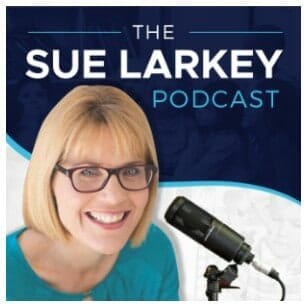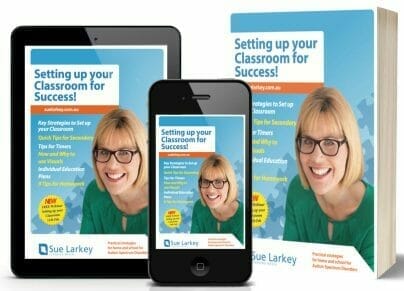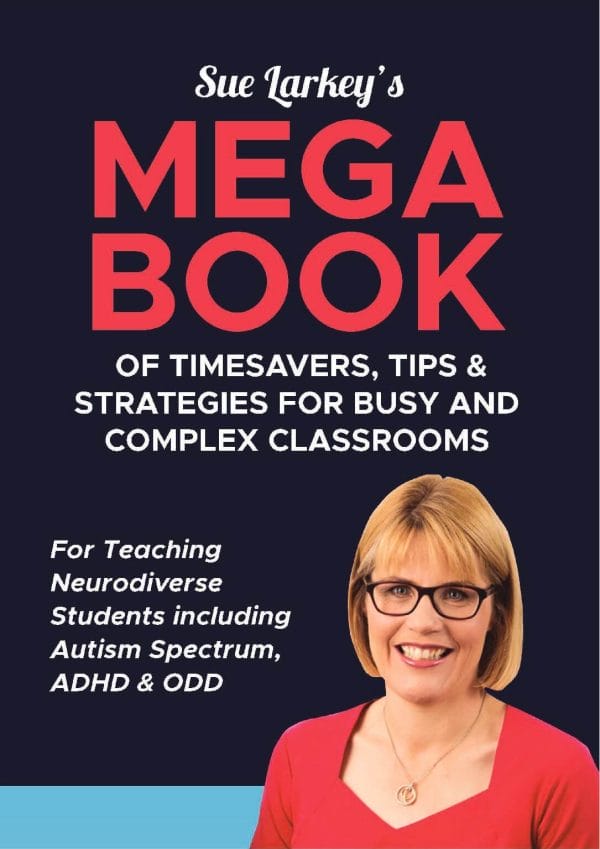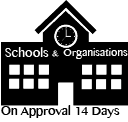Webinar replay – 18 key strategies for setting up your classroom
Unlock the secrets of Setting Up Your Classroom for results today!

**************************************
Join me for an upcoming Workshop:
Can't make these Workshop dates? Join me for a self-paced on-demand course:
Sue Larkey On-Demand Workshops
**************************************
My Live Webinar last week was a success! But it’s not too late – sign up HERE to watch the Replay of the hour of power!
FREE sign up includes:
🎆 E-book
🎆 Webinar Replay
🎆 Handout
In the Free Webinar You Will Learn:
- How to Structure the Classroom to Reduce Behaviour
- Quick and Easy Adjustments to Implement, e.g. where to position a child
- How to make the most of your Support Time
- Using Students’ Strengths to Reduce Stress
- Supporting Students Socially and Emotionally
- How to Identify the Underlying Causes of Disengagement/Behaviour
- 1 hour of POWER – Strategies to Make a Difference to You and the Kids you know

18 Key STRATEGIES FOR SETTING UP YOUR CLASSROOM
Excerpt from the free E-book Setting Up Your Classroom For Success by Sue Larkey
1. Position in Classroom
Seating, mat time, assembly, parades, etc.
Have a set position for the student which takes into account:
- Who they are next to
- Where in the room or group they are
- How close they are to the teacher
- Some students prefer to be near a door so they can leave if anxiety is building (particularly in secondary school)
- Distractions
-
- Whether they are too close to favourite acitivies like books, computers, Lego, etc.
- Sensory distrations – noises, smells, lighting, objects hanging too close
-
2. Bags / Lockers / Tote Boxes
Ensure neurodiverse students are at the quiet end of the row. Students often don’t like being touched, feeling crowded or the noise that happens in the busy areas.
3. Writing
60% of students with ASD have dysgraphia. This means handwriting can be messy, slow or sometimes even avoided, especially as they get older. You may need to consider allowing iPads, computers and other forms of technology as their means of writing as the goal is that they do the work. In the younger years pencil grips can support handwriting skills.
4. Organisation
ASD students often find organisation of their school equipment very difficult. Limit the number of books, and equipment, perhaps set up system like colour coding to help with organisation.
5. Quiet Area
Ensure there is an area where the student can retreat to if they are feeling overwhelmed. This can be a quiet table, reading corner, outside the classroom in hallway, alcove, office, etc. Some students also need to be placed near a door in the classroom or assembly as they need a perceived escape route.
6. Teacher Assistants / Education Support Officers
Consider how best to use support time effectively in the first few weeks. You may need them to make additional support materials, schedules, visuals, social stories, organisation, etc. See Teacher Assistants Big Red Book of Ideas.
7. Schedules / Timetables / Timers
These are VITAL no matter what age. This may be in a range of formats such as photos, visuals or words. Using a Timer supports the schedule and allows students to know HOW LONG activities will take. Click here to buy timers.
Are you?
- Passing on a student with Neurodiversity to another educator next year
- Do you know a student who will be changing teachers, classrooms, or school settings in 2026
- Planning your staff, classes for 2026
Now is the time to prepare for 2026.
By joining my course, you will get the knowledge, skills and strategies to set yourself and your students up for success in 2026.
If there's even a remote possibility of having a child with Neurodiversity in your classroom next year, join me to prepare now.
Training in the first term often presents challenges:
- Don't want a day out for training when setting up class at the start of the year.
- Students with neurodiversity may start off dysregulated because the necessary structures and strategies are not yet in place.
- Educators find themselves playing catch-up while addressing 'behaviours'.
- Many educators feel overwhelmed.
UNDERSTANDING AuDHD: Teaching & Supporting Students with Autism and ADHD Co-occurrence
✅ 2 Hours, 8 Lessons
✅ 6 Weeks to Complete 🎁 Bonus 6 Months Access (available until 28 Oct 25)
✅ Certificate of Completion
✅ Lesson Transcripts
 2 Hours
2 Hours

$149

8. Note Pad and Pen
Always carry a note book and pen for when things change – we tend to talk too much. These children are visual and if you can write it down or draw a picture it can stop behaviour escalating.
9. Reading
Be aware many students have hyperlexia where they can decipher written words but do not comprehend what they are reading.
10. Recess / Lunch
Make sure they know boundaries, days they are allowed on equipment, where to go if there’s a problem, safe places, when the library is open, clubs they can join, etc. Have solutions in place for common playground behaviours. Consider using lunchtime clubs and passive playgrounds.
11. Toilet / Drink
Many students with ASD will not access these at the same time as other students. It is recommended you send them out during class time to the toilet and get a drink as this can impact on their learning. BE AWARE they may not ask you to go to the toilet – you will need to send them.
Interoception is the ability to understand the signals your body is telling you. Many children with Autism Spectrum struggle with interoceptive sense, and cannot tell when they are thirsty or need the toilet. Learn more here.
12. Sensory Tools
Many students require sensory tools to focus, process or calm. You will probably need to provide a range of sensory tools for the student. This may include a sensory mat to sit on, fidget tools, chewy necklaces, tubes or pencil toppers.
13. Eating
Because of their sensory processing difficulties some students find it hard to eat at appropriate times because the smells of other student’s food or even the sound of them eating many be overwhelming. You may need to allow them to eat separately from other students.
**Early Years**: please note the above considerations are also important for your setting. You may need to also consider structure for nap times and often you will encounter more sensory issues because of the type of activities the children are engaged in, for example more play and craft activities can mean more sensory activities.
Learn more about sensory strategies on page 109 of Sue Larkey’s MEGA BOOK!
Sue Larkey’s MEGA BOOK of Timesavers, Tips & Strategies for Busy and Complex Classrooms
A MEGA book full of my most Popular Blogs, Tip Sheets and more in one easy to use reference! This book is for all ages and stages, for teaching neurodiverse students including Autism Spectrum, ADHD, ODD, PDA and more!
Includes index to quickly look up Topic & Tips, as well as ideas for all parts of teaching and looking after neurodiverse children. 142 pages of Strategies & Tips at YOUR Fingertips.
14. Lining Up
Have a set place or partner in the line.
15. Partners / Group Work / Teams
Select groups in advance. Consider students who are supportive and good role models.
11 in stock
16. Changing Environments / Staff
Having a timetable is vital as it pre-warns about upcoming changes. Transition periods (e.g. between class, start and end of the year, etc.) are the periods which have the most behaviour. Learn more about why change = behaviour here.
17. Classroom Expectations
Make clear, concise and explicit rules.
18. Parents / Carers
Let staff know any additional or successful strategies to further support your child, and vice versa. The best care for the children you know will come from a collaboration between school and home.


 2 Hours
2 Hours


 Sorry we no longer ship items outside Australia. Please consider the digital versions of Sue’s Books –
Sorry we no longer ship items outside Australia. Please consider the digital versions of Sue’s Books – 